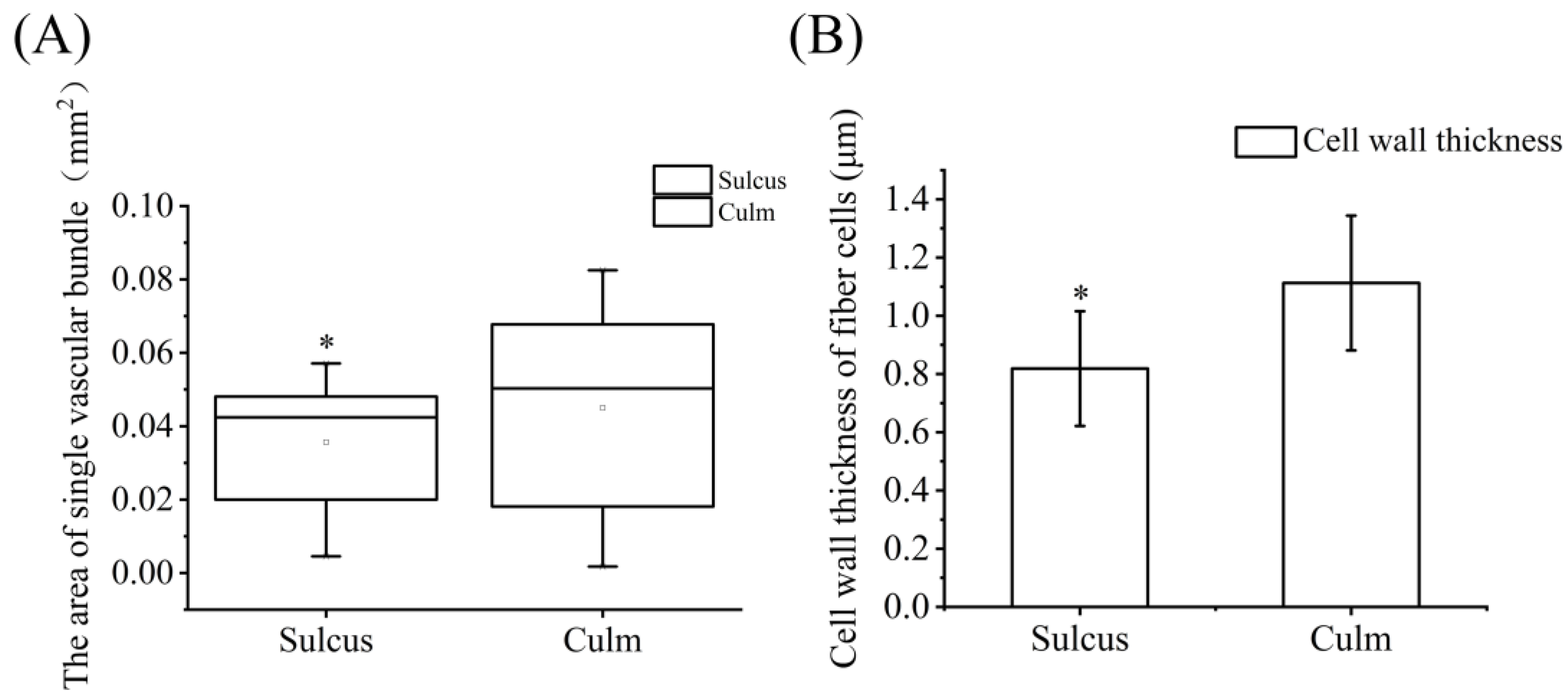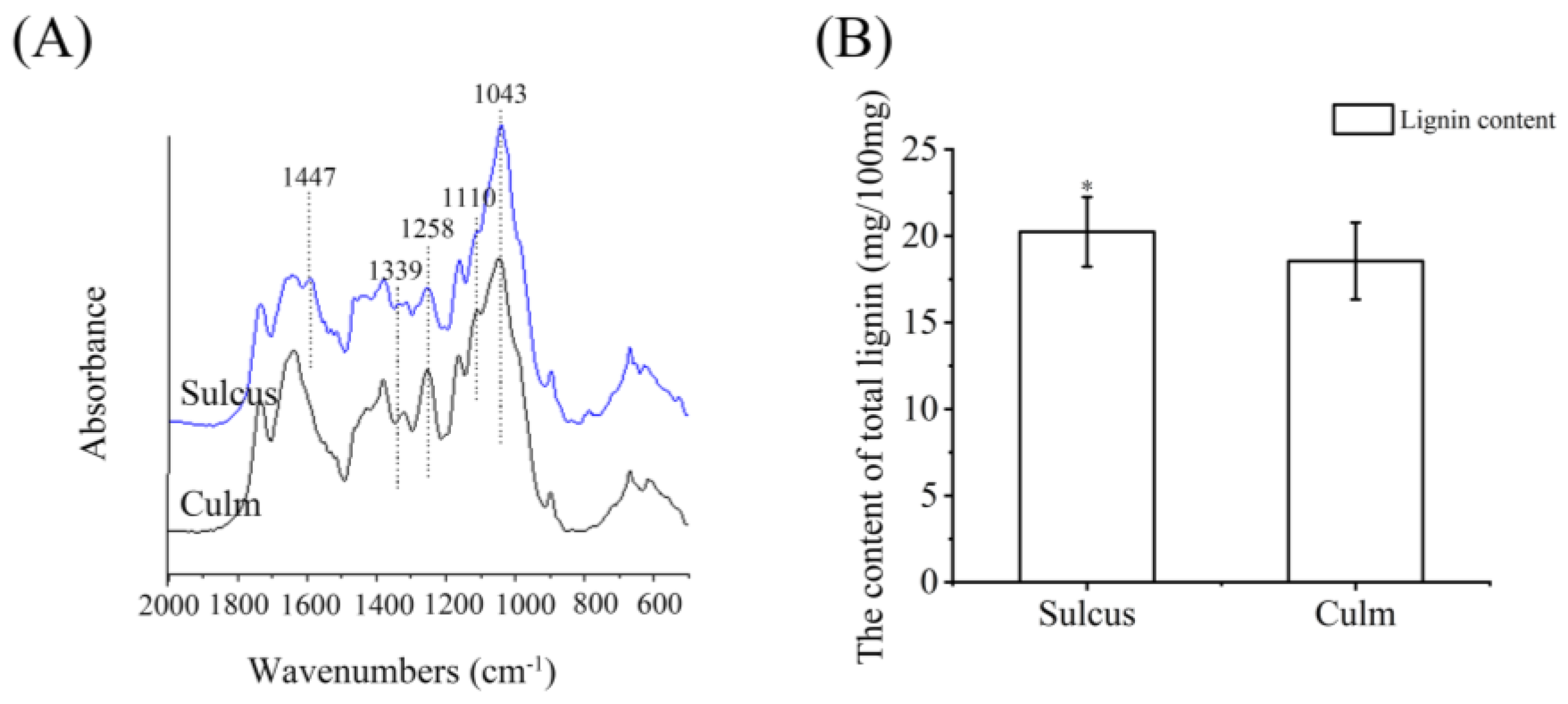Identification of Structural Differentiation and Differentially Expressed Genes between Sulcus and Culm of Phyllostachys violascens cv. Viridisulcata
Abstract
:1. Introduction
2. Materials and Methods
2.1. Plant Materials
2.2. Scanning Electron Microscopy
2.3. Light Microscopy and Cell Wall Thickness Measurement
2.4. FT-IR and Lignin Content Analysis
2.5. Transcriptome Analysis
2.6. Quantitative Real-Time PCR
3. Results
3.1. Histological Analysis of Internode Cross-Sections
3.2. FT-IR Analysis and Lignin Content Measurement
3.3. The Lignin Biosynthesis Genes Differentially Expressed between Sulcus and Culm
4. Discussion
4.1. Phenotype Analysis
4.2. Bamboo Culm and Sulcus Composition Analysis
4.3. Genes May Contribute to Lignin Biosynthesis in Bamboo Internodes
5. Conclusions
Supplementary Materials
Author Contributions
Funding
Data Availability Statement
Conflicts of Interest
References
- Pei, J.L.; Wang, Y.; Zhuo, J.; Gao, H.B.; Vasupalli, N.; Hou, D.; Lin, X. Complete Chloroplast Genome Features of Dendrocalamusfarinosus and Its Comparison and Evolutionary Analysis with Other Bambusoideae Species. Genes 2022, 13, 1519. [Google Scholar] [CrossRef] [PubMed]
- Vasupalli, N.; Hou, D.; Singh, R.M.; Wei, H.T.; Zou, L.H.; Yrjälä, K.; Wu, A.; Lin, X. Homo-and hetero-dimers of CAD enzymes regulate lignification and abiotic stress response in Moso Bamboo. Int. J. Mol. Sci. 2021, 22, 12917. [Google Scholar] [CrossRef] [PubMed]
- Wei, H.T.; Hou, D.; Ashraf, M.F.; Lu, H.W.; Zhuo, J.; Pei, J.L.; Qian, Q.X. Metabolic Profiling and Transcriptome Analysis Reveal the Key Role of Flavonoids in Internode Coloration of Phyllostachys violascens cv. Viridisulcata. Front. Plant Sci. 2022, 12, 3413. [Google Scholar] [CrossRef]
- Ye, S.; Chen, G.; Kohnen, M.V.; Wang, W.; Cai, C.; Ding, W.S.; Wu, C.; Gu, L.; Zheng, Y.; Ma, X.; et al. Robust CRISPR/Cas9 mediated genome editing and its application in manipulating plant height in the first generation of hexaploid Ma bamboo (Dendrocalamus latiflorus Munro). Plant Biotechnol. J. 2020, 18, 1501–1503. [Google Scholar] [CrossRef] [PubMed]
- Fang, W.; Gui, R.Y.; Ma, L.F.; Jin, A.W.; Lin, X.C.; Yu, X.J.; Ma, L.J.; Qian, J. Chinese Economic Bamboo; China Science Publishing & Media: Beijing, China, 2015; p. 402. [Google Scholar]
- Jin, H.Y.; Zhi, W.Z. Design of Household Multi-Function Vacuum Cleaner. Adv. Mater. Res. 2014, 945, 266–269. [Google Scholar] [CrossRef]
- Song, C.; Igarashi, M.; Ikei, H.; Miyazaki, Y. Physiological effects of viewing fresh red roses. Complement. Ther. Med. 2017, 35, 78–84. [Google Scholar] [CrossRef]
- Zheng, J.M.; Tian, M.W.K.; Jiang, D.H.; Li, M.; Ye, J.; Chen, L.Y.; He, T.; Zheng, Y. Which ornamental features of bamboo plants will attract the people most? Urban For. Urban Green. 2021, 61, 127101. [Google Scholar] [CrossRef]
- Lin, X.C.; Ruan, X.S.; Lou, Y.F.; Guo, X.Q.; Fang, W. Genetic similarity among cultivars of Phyllostachys pubescens. Plant Syst. Evol. 2009, 277, 67–73. [Google Scholar] [CrossRef]
- Lin, X.C.; Lou, Y.F.; Zhang, Y.Z.; Yuan, X.L.; He, J.C.; Fang, W. Identification of Genetic Diversity Among Cultivars of Phyllostachys violascens Using ISSR, SRAP and AFLP Markers. Bot. Rev. 2011, 77, 223–232. [Google Scholar] [CrossRef]
- Xia, X.; Gui, R.; Yang, H.; Fu, Y.; Wei, F.; Zhou, M. Identification of genes involved in color variation of bamboo culms by suppression subtractive hybridization. Plant Physiol. Biochem. 2015, 97, 156–164. [Google Scholar] [CrossRef]
- Jin, Y.C.; Yuan, K. Studies on the functional components and bioactivity and the relativity of bamboo shoots and shells. Adv. Mater. Res. 2011, 108, 314–319. [Google Scholar] [CrossRef]
- Cai, K.; Zhu, L.; Zhang, K.; Li, L.; Zhao, Z.; Zeng, W.; Lin, X. Development and characterization of EST-SSR markers from RNA-Seq data in Phyllostachys violascens. Front. Plant Sci. 2019, 10, 50. [Google Scholar] [CrossRef] [PubMed]
- Młodzińska, E. Survey of plant pigments: Molecular and environmental determinants of plant colors. Acta Biol. Crac. Ser. Bot. 2009, 51, 7–16. [Google Scholar] [CrossRef]
- Kanzawa, E.; Aoyagi, S.; Nakano, T. Vascular bundle shape in cross-section and relaxation properties of Moso bamboo (Phyllostachys pubescens). Mater. Sci. Eng. C 2011, 31, 1050–1054. [Google Scholar] [CrossRef]
- Wang, K.L.; Wang, B.; Hu, R.; Zhao, X.; Li, H.; Zhou, G.; Song, L.; Wu, A.M. Characterization of hemicelluloses in Phyllostachys edulis (moso bamboo) culm during xylogenesis. Carbohydr. Polym. 2019, 221, 127–136. [Google Scholar] [CrossRef]
- Qin, W.; Yin, Q.; Chen, J.; Zhao, X.; Yue, F.; He, J.; Yang, L.; Liu, L.; Zeng, Q.; Lu, F.; et al. The Class II KNOX transcription factors KNAT3 and KNAT7 synergistically regulate monolignol biosynthesis in Arabidopsis. J. Exp. Bot. 2020, 71, 5469–5483. [Google Scholar] [CrossRef]
- Love, M.I.; Huber, W.; Anders, S. Moderated estimation of fold change and dispersion for RNA-seq data with DESeq2. Genome Biol. 2014, 15, 550. [Google Scholar] [CrossRef]
- Chen, C.J.; Chen, H.; Zhang, Y.; Thomas, H.R.; Frank, M.H.; He, Y.H.; Xia, R. TBtools: An Integrative Toolkit Developed for Interactive Analyses of Big Biological Data. Mol. Plant 2020, 13, 1194–1202. [Google Scholar] [CrossRef]
- Hou, D.; Zhao, Z.Y.; Hu, Q.T.; Li, L.; Vasupalli, N.; Zhuo, J.; Zeng, W.; Wu, A.; Lin, X. PeSNAC-1 a NAC transcription factor from moso bamboo (Phyllostachys edulis) confers tolerance to salinity and drought stress in transgenic rice. Tree Physiol. 2020, 40, 1792–1806. [Google Scholar] [CrossRef]
- Schmittgen, T.D.; Livak, K.J. Analyzing real-time PCR data by thecomparative CT method. Nat. Protoc. 2008, 3, 1101–1108. [Google Scholar] [CrossRef]
- Fan, C.; Ma, J.; Guo, Q.; Li, X.; Wang, H.; Lu, M. Selection of reference genes for quantitative real-time PCR in bamboo (Phyllostachys edulis). PLoS ONE 2013, 8, e56573. [Google Scholar] [CrossRef]
- Hou, D.; Li, L.; Ma, T.F.; Pei, J.L.; Zhao, Z.Y.; Lu, M.Z.; Wu, A.; Lin, X. The SOC1-like gene BoMADS50 is associated with the flowering of Bambusa oldhamii. Hortic. Res. 2021, 8, 133. [Google Scholar] [CrossRef] [PubMed]
- Schwanninger, M.; Rodrigues, J.C.; Pereira, H.; Hinterstoisser, B. Effects of short-time vibratory ball milling on the shape of FT-IR spectra of wood and cellulose. Vib. Spectrosc. 2004, 36, 23–40. [Google Scholar] [CrossRef]
- Åkerholm, M.; Salmén, L. The Oriented Structure of Lignin and its Viscoelastic Properties Studied by Static and Dynamic FT-IR Spectroscopy. Holzforschung 2003, 57, 459–465. [Google Scholar] [CrossRef]
- Kačuráková, M.; Smith, A.C.; Gidley, M.J.; Wilson, R.H. Molecular interactions in bacterial cellulose composites studied by 1D FT-IR and dynamic 2D FT-IR spectroscopy. Carbohydr. Res. 2002, 337, 1145–1153. [Google Scholar] [CrossRef]
- Cheng, S.; Huang, A.; Wang, S.; Zhang, Q. Effect of different heat treatment temperatures on the chemical composition and structure of Chinese fir wood. BioResources 2016, 11, 4006–4016. [Google Scholar] [CrossRef]
- Legay, S.; Sivadon, P.; Blervacq, A.; Pavy, N.; Baghdady, A.; Tremblay, L.; Levasseur, C.; Ladouce, N.; Lapierre, C.; Séguin, A.; et al. EgMYB1, an R2R3 MYB transcription factor from eucalyptus negatively regulates secondary cell wall formation in Arabidopsis and poplar. New Phytol. 2021, 188, 774–786. [Google Scholar] [CrossRef] [PubMed]
- Kamran, M.; Cui, W.; Ahmad, I.; Meng, X.; Zhang, X.; Su, W.; Chen, J.; Ahmad, S.; Fahad, S.; Han, Q.; et al. Effect of paclobutrazol, a potential growth regulator on stalk mechanical strength, lignin accumulation and its relation with lodging resistance of maize. Plant Growth Regul. 2018, 84, 317–332. [Google Scholar] [CrossRef]
- Yoon, J.; Choi, H.; An, G. Roles of lignin biosynthesis and regulatory genes in plant development. J. Integr. Plant Biol. 2015, 57, 902–912. [Google Scholar] [CrossRef]
- Zhao, Q.; Dixon, R.A. Transcriptional networks for lignin biosynthesis: More complex than we thought? Trends Plant Sci. 2011, 16, 227–233. [Google Scholar] [CrossRef]
- Shang, L.L.; Sun, Z.J.; Liu, X.; Jiang, Z.H. A novel method for measuring mechanical properties of vascular bundles in moso bamboo. J. Wood Sci. 2015, 61, 562–568. [Google Scholar] [CrossRef]
- Li, J.; Xu, H.C.; Yu, Y.; Chen, H.; Yi, W.K.; Wang, H.K. Intelligent analysis technology of bamboo structure. Part I: The variability of vascular bundles and fiber sheath area. Ind. Crops Prod. 2021, 174, 114163. [Google Scholar] [CrossRef]
- Mohd, T.B.M.; Bhat, I.U.H.; Mohmod, A.L.; Aditiawati, P.; Abdul Khalil, H.P.S. Thermal and FT-IR Characterization of Gigantochloa levis and Gigantochloa scortechinii Bamboo, a Naturally Occurring Polymeric Composite. J. Polym. Environ. 2013, 21, 534–544. [Google Scholar] [CrossRef]
- Sun, B.; Huang, A.; Wang, Y.; Liu, J. Natural bamboo (Neosinocalamus affinis Keng) fiber identification using FT-IR and 2D-IR correlation spectroscopy. J. Nat. Fibers 2015, 12, 796907. [Google Scholar] [CrossRef]
- Cai, Q.; Fan, Z.; Chen, J.; Guo, W.; Ma, F.; Sun, S.; Hu, L.; Zhou, Q. Dissolving process of bamboo powder analyzed by FT-IR spectroscopy. J. Mol. Struct. 2018, 1171, 639–643. [Google Scholar] [CrossRef]
- Ashraf, M.F.; Hou, D.; Hussain, Q.; Imran, M.; Pei, J.; Ali, M.; Shehzad, A.; Anwar, M.; Noman, A.; Waseem, M.; et al. Entailing the Next-Generation Sequencing and Metabolome for Sustainable Agriculture by Improving Plant Tolerance. Int. J. Mol. Sci. 2022, 23, 651. [Google Scholar] [CrossRef]
- Soltani, B.M.; Ehlting, J.; Douglas, C.J. Genetic analysis and epigenetic silencing of At4CL1 and At4Cl2 expression in transgenic Arabidopsis. Biotechnol. J. 2006, 1, 1124–1136. [Google Scholar] [CrossRef]
- Schilmiller, A.L.; Stout, J.; Weng, J.K.; Humphreys, J.; Ruegger, M.O.; Chapple, C. Mutations in the cinnamate 4-hydroxylase gene impact metabolism, growth and development in Arabidopsis. Plant J. 2009, 60, 771–782. [Google Scholar] [CrossRef]
- Gui, J.; Shen, J.; Li, L. Functional characterization of evolutionarily divergent 4-coumarate: Coenzyme a ligases in rice. Plant Physiol. 2011, 157, 574–586. [Google Scholar] [CrossRef]
- Xia, G.S. Repression of Lignin Synthesis in Rice by C4H and 4CL Using RNAi. Int. J. Biosci. Biochem. Bioinform. 2013, 3, 226–228. [Google Scholar] [CrossRef]
- Hu, W.J.; Kawaoka, A.; Tsai, C.J.; Lung, J.; Osakabe, K.; Ebinuma, H.; Chiang, V.L. Compartmentalized expression of two structurally and functionally distinct 4-coumarate:CoA ligase genes in aspen (Populus tremuloides). Proc. Natl. Acad. Sci. USA 1998, 95, 5407–5541. [Google Scholar] [CrossRef] [PubMed]
- Taskhiri, M.S.; Jeswani, H.; Geldermann, J.; Azapagic, A. Optimizing cascaded utilization of wood resources considering economic and environmental aspects. Comput. Chem. Eng. 2019, 124, 302–316. [Google Scholar] [CrossRef]
- Peng, Z.; Lu, Y.; Li, L.; Zhao, Q.; Feng, Q.; Gao, Z.; Lu, H.; Hu, T.; Yao, N.; Liu, K.; et al. The draft genome of the fast-growing non-timber forest species moso bamboo (Phyllostachys heterocycla). Nat. Genet. 2013, 45, 456–461. [Google Scholar] [CrossRef]
- Xie, J.L.; Qi, J.Q.; Hu, T.X.; Hoop, C.F.D.; Hse, C.Y.; Shupe, T.F. Effect of fabricated density and bamboo species on physical–mechanical properties of bamboo fiber bundle reinforced composites. J. Mater. Sci. 2016, 51, 7480–7490. [Google Scholar] [CrossRef]





| Tissue | The Distribution Density of Vascular Bundles (per·mm2) | Vascular Bundle’s Structural Parameters | |
|---|---|---|---|
| Maximum Length (mm) | Maximum Width (mm) | ||
| sulcus | 13.33 ± 0.351 a | 0.28 ± 0.02 a | 0.29 ± 0.01 a |
| culm | 11.56 ± 0.426 b | 0.38 ± 0.01 b | 0.32 ± 0.02 b |
Disclaimer/Publisher’s Note: The statements, opinions and data contained in all publications are solely those of the individual author(s) and contributor(s) and not of MDPI and/or the editor(s). MDPI and/or the editor(s) disclaim responsibility for any injury to people or property resulting from any ideas, methods, instructions or products referred to in the content. |
© 2023 by the authors. Licensee MDPI, Basel, Switzerland. This article is an open access article distributed under the terms and conditions of the Creative Commons Attribution (CC BY) license (https://creativecommons.org/licenses/by/4.0/).
Share and Cite
Wei, H.-T.; Vasupalli, N.; Hou, D.; Pei, J.-L.; Lu, H.-W.; Wu, A.-M.; Lin, X.-C. Identification of Structural Differentiation and Differentially Expressed Genes between Sulcus and Culm of Phyllostachys violascens cv. Viridisulcata. Forests 2023, 14, 1073. https://doi.org/10.3390/f14061073
Wei H-T, Vasupalli N, Hou D, Pei J-L, Lu H-W, Wu A-M, Lin X-C. Identification of Structural Differentiation and Differentially Expressed Genes between Sulcus and Culm of Phyllostachys violascens cv. Viridisulcata. Forests. 2023; 14(6):1073. https://doi.org/10.3390/f14061073
Chicago/Turabian StyleWei, Han-Tian, Naresh Vasupalli, Dan Hou, Jia-Long Pei, Hai-Wen Lu, Ai-Min Wu, and Xin-Chun Lin. 2023. "Identification of Structural Differentiation and Differentially Expressed Genes between Sulcus and Culm of Phyllostachys violascens cv. Viridisulcata" Forests 14, no. 6: 1073. https://doi.org/10.3390/f14061073






